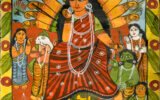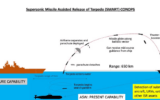
January 09 2024 Prelims Practice Questions (PPQs)
Subscribe to Never Miss an Important Update! Assured Discounts on New Products!
Must Join PMF IAS Telegram Channel & PMF IAS History Telegram Channel
- These Prelims Practice Questions (PPQs) are based on PMF IAS Daily Current Affairs.
- The daily current affairs are uploaded every day by 8 PM. You can read the Daily Current Affairs from here.
- Subscribers of the “Current Affairs” course can Download Daily Current Affairs in PDF/DOC from here.
[Quiz] Daily Prelims Practice Questions (PPQs) – January 09 2024
0 of 7 questions completed
Questions:
- 1
- 2
- 3
- 4
- 5
- 6
- 7
Information
These MCQs are based on PMF IAS Daily Current Affairs. The daily current affairs are uploaded every day by 8 PM. You can read the Daily Current Affairs from here. Subscribers of the “Current Affairs” course can Download Daily Current Affairs in PDF/DOC from here.
You have already completed the Test before. Hence you can not start it again.
Test is loading...
You must sign in or sign up to start the Test.
You have to finish following quiz, to start this Test:
Your results are here!! for" [Quiz] Daily Prelims Practice Questions (PPQs) – January 09 2024 "
0 of 7 questions answered correctly
Your time:
Time has elapsed
Your Final Score is : 0
You have attempted : 0
Number of Correct Questions : 0 and scored 0
Number of Incorrect Questions : 0 and Negative marks 0
| Average score |
|
| Your score |
|
-
Not categorized
You have attempted: 0
Number of Correct Questions: 0 and scored 0
Number of Incorrect Questions: 0 and Negative marks 0
| Pos. | Name | Entered on | Points | Result |
|---|---|---|---|---|
| Table is loading | ||||
| No data available | ||||
- 1
- 2
- 3
- 4
- 5
- 6
- 7
- Answered
- Review
-
Question 1 of 7
1. Question
Q1. {Social Sector – Health} Consider the following statements about Poverty in India:
- In a given year in India, official poverty lines are higher in some states than in others because poverty rates vary from State to State.
- Relative Poverty is dynamic in nature.
- Below Poverty Line Census is conducted by the Niti Aayog.
- Dadabhai Naoroji made the earliest estimation of poverty line in India.
How many of the above statement(s) is/are correct?
Correct
Explanation
Statement 1 is incorrect
- Poverty Lines would vary from state to state because of Inter State Price Differentials for different commodities.
- Poverty lines are estimated using the original state-specific poverty lines identified by the Expert Group and updating them to 2004-2005 prices using the Consumer Price Index of Agricultural Laborers (CPIAL) for rural poverty lines and Consumer Price Index for Industrial Workers (CPIIW) for urban poverty lines.
- According to the Planning Commission, in 2011-12, using the methodology suggested by Tendulkar committee, the poverty line is fixed at Rs 816 per person per month in rural areas and Rs 1,000 per person per month in urban areas.
- The Poverty line depends upon the income profile of the population and on the basis of consumer expenditure.
Statement 2 is correct
- Relative Poverty is defined as Income/resource inadequacy compared to societal standards.
- It can change with economic growth, social policies, and income distribution shifts, hence its dynamic in Nature.
Statement 3 is incorrect
- BPL Census is conducted by the Ministry of Rural Development (along with the partnership of state), in order to identify the poor households.
- Niti Aayog (earlier planning commission) estimates poverty using NSSO data.
- Every five years, NSSO conducts surveys to collect household consumption expenditure.
- Monthly per capita consumption expenditure is used to determine the poverty line.
Statement 4 is correct
- Dadabhai Naoroji through his book, “Poverty and Unbritish Rule in India” made the earliest estimation of poverty line (₹16 to ₹35 per capita per year).
- The poverty line proposed by him was based on the cost of a subsistence or minimum basic diet (rice or flour, dal, mutton, vegetables, ghee, vegetable oil, and salt).
Answer: (b) Only two; Difficulty Level: Medium
Incorrect
Explanation
Statement 1 is incorrect
- Poverty Lines would vary from state to state because of Inter State Price Differentials for different commodities.
- Poverty lines are estimated using the original state-specific poverty lines identified by the Expert Group and updating them to 2004-2005 prices using the Consumer Price Index of Agricultural Laborers (CPIAL) for rural poverty lines and Consumer Price Index for Industrial Workers (CPIIW) for urban poverty lines.
- According to the Planning Commission, in 2011-12, using the methodology suggested by Tendulkar committee, the poverty line is fixed at Rs 816 per person per month in rural areas and Rs 1,000 per person per month in urban areas.
- The Poverty line depends upon the income profile of the population and on the basis of consumer expenditure.
Statement 2 is correct
- Relative Poverty is defined as Income/resource inadequacy compared to societal standards.
- It can change with economic growth, social policies, and income distribution shifts, hence its dynamic in Nature.
Statement 3 is incorrect
- BPL Census is conducted by the Ministry of Rural Development (along with the partnership of state), in order to identify the poor households.
- Niti Aayog (earlier planning commission) estimates poverty using NSSO data.
- Every five years, NSSO conducts surveys to collect household consumption expenditure.
- Monthly per capita consumption expenditure is used to determine the poverty line.
Statement 4 is correct
- Dadabhai Naoroji through his book, “Poverty and Unbritish Rule in India” made the earliest estimation of poverty line (₹16 to ₹35 per capita per year).
- The poverty line proposed by him was based on the cost of a subsistence or minimum basic diet (rice or flour, dal, mutton, vegetables, ghee, vegetable oil, and salt).
Answer: (b) Only two; Difficulty Level: Medium
Unattempted
Explanation
Statement 1 is incorrect
- Poverty Lines would vary from state to state because of Inter State Price Differentials for different commodities.
- Poverty lines are estimated using the original state-specific poverty lines identified by the Expert Group and updating them to 2004-2005 prices using the Consumer Price Index of Agricultural Laborers (CPIAL) for rural poverty lines and Consumer Price Index for Industrial Workers (CPIIW) for urban poverty lines.
- According to the Planning Commission, in 2011-12, using the methodology suggested by Tendulkar committee, the poverty line is fixed at Rs 816 per person per month in rural areas and Rs 1,000 per person per month in urban areas.
- The Poverty line depends upon the income profile of the population and on the basis of consumer expenditure.
Statement 2 is correct
- Relative Poverty is defined as Income/resource inadequacy compared to societal standards.
- It can change with economic growth, social policies, and income distribution shifts, hence its dynamic in Nature.
Statement 3 is incorrect
- BPL Census is conducted by the Ministry of Rural Development (along with the partnership of state), in order to identify the poor households.
- Niti Aayog (earlier planning commission) estimates poverty using NSSO data.
- Every five years, NSSO conducts surveys to collect household consumption expenditure.
- Monthly per capita consumption expenditure is used to determine the poverty line.
Statement 4 is correct
- Dadabhai Naoroji through his book, “Poverty and Unbritish Rule in India” made the earliest estimation of poverty line (₹16 to ₹35 per capita per year).
- The poverty line proposed by him was based on the cost of a subsistence or minimum basic diet (rice or flour, dal, mutton, vegetables, ghee, vegetable oil, and salt).
Answer: (b) Only two; Difficulty Level: Medium
-
Question 2 of 7
2. Question
Q2. {Social Sector – Initiatives} Consider the following statements about Mulya Pravah 2.0:
- This is a PLI scheme for medical devices that aims to manufacture the components of high-end medical devices in the country to make them more cost-effective.
- The objective of this scheme is to establish domestic manufacturing capability of high-end medical devices under four target segments namely, Cancer care medical devices, Radiology & Imaging medical devices and Nuclear Imaging devices, Anaesthetics & Cardio-Respiratory medical devices and all Implants including implantable electronic devices.
How many of the above statement(s) is/are correct?
Correct
Explanation
Statement 1 is incorrect
- Mulya Pravah 2.0 was released by the University Grants Commission recently.
- It aims to build value-based institutions, including fundamental duties and constitutional values.
Statement 2 is incorrect
- Mulya Pravah 2.0 underscores the need for utmost administration transparency.
- It highlights the need for unbiased, objective decision-making in higher education institutions.
- It seeks to abolish the discriminatory privileges of officials and encourage punishing the corrupt.
- It mandates that provisions of the acts, policies, and procedures of universities should be upheld.
- Guidelines expect staff and student unions to “support the administration in development activities and raise issues in a dignified manner”.
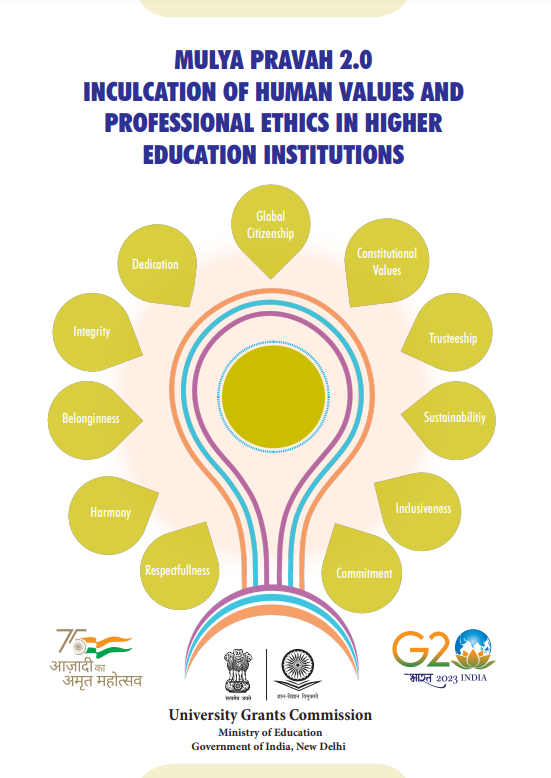
Answer: (d) Neither 1 nor 2; Difficulty Level: Medium
Incorrect
Explanation
Statement 1 is incorrect
- Mulya Pravah 2.0 was released by the University Grants Commission recently.
- It aims to build value-based institutions, including fundamental duties and constitutional values.
Statement 2 is incorrect
- Mulya Pravah 2.0 underscores the need for utmost administration transparency.
- It highlights the need for unbiased, objective decision-making in higher education institutions.
- It seeks to abolish the discriminatory privileges of officials and encourage punishing the corrupt.
- It mandates that provisions of the acts, policies, and procedures of universities should be upheld.
- Guidelines expect staff and student unions to “support the administration in development activities and raise issues in a dignified manner”.

Answer: (d) Neither 1 nor 2; Difficulty Level: Medium
Unattempted
Explanation
Statement 1 is incorrect
- Mulya Pravah 2.0 was released by the University Grants Commission recently.
- It aims to build value-based institutions, including fundamental duties and constitutional values.
Statement 2 is incorrect
- Mulya Pravah 2.0 underscores the need for utmost administration transparency.
- It highlights the need for unbiased, objective decision-making in higher education institutions.
- It seeks to abolish the discriminatory privileges of officials and encourage punishing the corrupt.
- It mandates that provisions of the acts, policies, and procedures of universities should be upheld.
- Guidelines expect staff and student unions to “support the administration in development activities and raise issues in a dignified manner”.

Answer: (d) Neither 1 nor 2; Difficulty Level: Medium
-
Question 3 of 7
3. Question
Q3. {Agri – PDS} Consider the following statements:
- The families coming under the category of ‘below poverty line (BPL)’ only are eligible to receive subsidised food grains.
- The eldest woman in a household, of age 18 years or above, shall be the head of the household for the purpose of issuance of a ration card.
- Pregnant women and lactating mothers are entitled to a ‘take-home ration’ of 1600 calories per day during pregnancy and for six months thereafter.
How many of the above statement(s) is/are correct?
Correct
Explanation
Statement 1 is incorrect
- The Act provides coverage for nearly 2/3rd of the country’s total population, based on Census 2011 population estimates.
- 75% of rural and 50% of urban population is entitled to receive highly subsidized food grains under two categories i.e Antyodaya Anna Yojana (AAY) households and Priority Households (PHH).
- The Act entitles 35 kg of food grains as per Antyodaya Anna Yojana Households per month, whereas 5kg of food grains per Priority Households per person.
Statement 2 is correct
- Under the NFSA, for the purpose of issuing ration cards the eldest woman of a household aged 18 years or above would be considered as head.
Statement 3 is incorrect
- Pregnant women and lactating mothers are entitled to a nutritious “take home ration” of 600 Calories and a maternity benefit of at least Rs 6,000 for six months, says the official act.
Answer: (b) 2 Only; Difficulty Level: Medium
Incorrect
Explanation
Statement 1 is incorrect
- The Act provides coverage for nearly 2/3rd of the country’s total population, based on Census 2011 population estimates.
- 75% of rural and 50% of urban population is entitled to receive highly subsidized food grains under two categories i.e Antyodaya Anna Yojana (AAY) households and Priority Households (PHH).
- The Act entitles 35 kg of food grains as per Antyodaya Anna Yojana Households per month, whereas 5kg of food grains per Priority Households per person.
Statement 2 is correct
- Under the NFSA, for the purpose of issuing ration cards the eldest woman of a household aged 18 years or above would be considered as head.
Statement 3 is incorrect
- Pregnant women and lactating mothers are entitled to a nutritious “take home ration” of 600 Calories and a maternity benefit of at least Rs 6,000 for six months, says the official act.
Answer: (b) 2 Only; Difficulty Level: Medium
Unattempted
Explanation
Statement 1 is incorrect
- The Act provides coverage for nearly 2/3rd of the country’s total population, based on Census 2011 population estimates.
- 75% of rural and 50% of urban population is entitled to receive highly subsidized food grains under two categories i.e Antyodaya Anna Yojana (AAY) households and Priority Households (PHH).
- The Act entitles 35 kg of food grains as per Antyodaya Anna Yojana Households per month, whereas 5kg of food grains per Priority Households per person.
Statement 2 is correct
- Under the NFSA, for the purpose of issuing ration cards the eldest woman of a household aged 18 years or above would be considered as head.
Statement 3 is incorrect
- Pregnant women and lactating mothers are entitled to a nutritious “take home ration” of 600 Calories and a maternity benefit of at least Rs 6,000 for six months, says the official act.
Answer: (b) 2 Only; Difficulty Level: Medium
-
Question 4 of 7
4. Question
Q4. {Envi – Conservation} Eaglenest Wildlife Sanctuary, recently seen in news is located in which state?
Correct
Explanation
- Context: An IISc study conducted in Arunachal Pradesh’s Eaglenest Wildlife Sanctuary reveals the threat posed to montane birds by logging and climate change.
- Eaglenest or Eagle’s Nest Wildlife Sanctuary is a protected area of India in the Himalayan foothills of West Kameng District, Arunachal Pradesh. It conjoins Sessa Orchid Sanctuary to the northeast and Pakhui Tiger Reserve across the Kameng river to the east.
- It is a part of the Kameng Elephant Reserve.
- Eaglenest is notable as a prime birding site due to the extraordinary variety, numbers and accessibility of species.
- Eaglenest derives its name from Red Eagle Division of the Indian army which was posted in the area in the 1950s.
- The Critical Ecosystem Partnership Fund (CEPF), a consortium of major international and regional organizations, has identified the Eastern Himalayan region around Arunachal Pradesh (Nepal, Bhutan and all of Northeast India) as a critical global biodiversity rich area deserving of conservation focus.
- Eaglenest Wildlife Sanctuary is in the Conservation International Himalaya Biodiversity Hotspot area.
- BirdLife International has designated Eaglenest and Sessa sanctuaries as an Important Bird Area, with Blyth’s tragopan identified as a vulnerable species of the area.
Answer: (a) Arunachal Pradesh; Difficulty Level: Medium
Incorrect
Explanation
- Context: An IISc study conducted in Arunachal Pradesh’s Eaglenest Wildlife Sanctuary reveals the threat posed to montane birds by logging and climate change.
- Eaglenest or Eagle’s Nest Wildlife Sanctuary is a protected area of India in the Himalayan foothills of West Kameng District, Arunachal Pradesh. It conjoins Sessa Orchid Sanctuary to the northeast and Pakhui Tiger Reserve across the Kameng river to the east.
- It is a part of the Kameng Elephant Reserve.
- Eaglenest is notable as a prime birding site due to the extraordinary variety, numbers and accessibility of species.
- Eaglenest derives its name from Red Eagle Division of the Indian army which was posted in the area in the 1950s.
- The Critical Ecosystem Partnership Fund (CEPF), a consortium of major international and regional organizations, has identified the Eastern Himalayan region around Arunachal Pradesh (Nepal, Bhutan and all of Northeast India) as a critical global biodiversity rich area deserving of conservation focus.
- Eaglenest Wildlife Sanctuary is in the Conservation International Himalaya Biodiversity Hotspot area.
- BirdLife International has designated Eaglenest and Sessa sanctuaries as an Important Bird Area, with Blyth’s tragopan identified as a vulnerable species of the area.
Answer: (a) Arunachal Pradesh; Difficulty Level: Medium
Unattempted
Explanation
- Context: An IISc study conducted in Arunachal Pradesh’s Eaglenest Wildlife Sanctuary reveals the threat posed to montane birds by logging and climate change.
- Eaglenest or Eagle’s Nest Wildlife Sanctuary is a protected area of India in the Himalayan foothills of West Kameng District, Arunachal Pradesh. It conjoins Sessa Orchid Sanctuary to the northeast and Pakhui Tiger Reserve across the Kameng river to the east.
- It is a part of the Kameng Elephant Reserve.
- Eaglenest is notable as a prime birding site due to the extraordinary variety, numbers and accessibility of species.
- Eaglenest derives its name from Red Eagle Division of the Indian army which was posted in the area in the 1950s.
- The Critical Ecosystem Partnership Fund (CEPF), a consortium of major international and regional organizations, has identified the Eastern Himalayan region around Arunachal Pradesh (Nepal, Bhutan and all of Northeast India) as a critical global biodiversity rich area deserving of conservation focus.
- Eaglenest Wildlife Sanctuary is in the Conservation International Himalaya Biodiversity Hotspot area.
- BirdLife International has designated Eaglenest and Sessa sanctuaries as an Important Bird Area, with Blyth’s tragopan identified as a vulnerable species of the area.
Answer: (a) Arunachal Pradesh; Difficulty Level: Medium
-
Question 5 of 7
5. Question
Q5. {Prelims – In News} Consider the following statements with respect to Sela Tunnel:
- Sela Tunnel is being constructed by the National Highways Authority of India (NHAI).
- The technology used here involves combination of silane and a nano-polymer with some amount of cement, which gives strength and flexibility to the bitumen pavement.
- Once completed, it will be the world’s longest bi-lane tunnel.
Which of the above statement is/are correct?
Correct
Explanation
Statement 1 is incorrect
- Sela Tunnel is an under-construction road tunnel at 3,000 metres (9,800 ft) which will ensure all-weather connectivity between Guwahati in Assam and Tawang in the Indian state of Arunachal Pradesh.
- This strategic tunnel is being constructed by the Border Roads Organisation (BRO) under Project Vartak.
- It will enhance Indian military’s capabilities in combating the threat of China’s Western Theater Command opposite India’s eastern sector of Line of Actual Control.
Statement 2 is incorrect
- The Border Roads Organisation (BRO) has successfully utilised an indigenous road construction technology to build high-altitude bituminous road sections at the Sela tunnel and LGG-Damteng-Yangste (LDY) road near the India-China border in Arunachal Pradesh.
- The indigenous technology, ‘Rejupave‘, developed by India’s oldest and premier road research organisation, CSIR-Central Road Research Institute (CSIR-CRRI), is beneficial in constructing high-altitude bituminous roads at low and sub-zero temperature conditions.
Statement 3 is correct
- The Sela Tunnel once completed will offer the world the longest bi-lane tunnel at an altitude above 13,000 feet.
- The Sela Tunnel is 400 meters below the Sela Pass and once the tunnel is completed, people will be able to pass through it even in winter.
Answer: (a) Only one; Difficulty Level: Medium
Incorrect
Explanation
Statement 1 is incorrect
- Sela Tunnel is an under-construction road tunnel at 3,000 metres (9,800 ft) which will ensure all-weather connectivity between Guwahati in Assam and Tawang in the Indian state of Arunachal Pradesh.
- This strategic tunnel is being constructed by the Border Roads Organisation (BRO) under Project Vartak.
- It will enhance Indian military’s capabilities in combating the threat of China’s Western Theater Command opposite India’s eastern sector of Line of Actual Control.
Statement 2 is incorrect
- The Border Roads Organisation (BRO) has successfully utilised an indigenous road construction technology to build high-altitude bituminous road sections at the Sela tunnel and LGG-Damteng-Yangste (LDY) road near the India-China border in Arunachal Pradesh.
- The indigenous technology, ‘Rejupave‘, developed by India’s oldest and premier road research organisation, CSIR-Central Road Research Institute (CSIR-CRRI), is beneficial in constructing high-altitude bituminous roads at low and sub-zero temperature conditions.
Statement 3 is correct
- The Sela Tunnel once completed will offer the world the longest bi-lane tunnel at an altitude above 13,000 feet.
- The Sela Tunnel is 400 meters below the Sela Pass and once the tunnel is completed, people will be able to pass through it even in winter.
Answer: (a) Only one; Difficulty Level: Medium
Unattempted
Explanation
Statement 1 is incorrect
- Sela Tunnel is an under-construction road tunnel at 3,000 metres (9,800 ft) which will ensure all-weather connectivity between Guwahati in Assam and Tawang in the Indian state of Arunachal Pradesh.
- This strategic tunnel is being constructed by the Border Roads Organisation (BRO) under Project Vartak.
- It will enhance Indian military’s capabilities in combating the threat of China’s Western Theater Command opposite India’s eastern sector of Line of Actual Control.
Statement 2 is incorrect
- The Border Roads Organisation (BRO) has successfully utilised an indigenous road construction technology to build high-altitude bituminous road sections at the Sela tunnel and LGG-Damteng-Yangste (LDY) road near the India-China border in Arunachal Pradesh.
- The indigenous technology, ‘Rejupave‘, developed by India’s oldest and premier road research organisation, CSIR-Central Road Research Institute (CSIR-CRRI), is beneficial in constructing high-altitude bituminous roads at low and sub-zero temperature conditions.
Statement 3 is correct
- The Sela Tunnel once completed will offer the world the longest bi-lane tunnel at an altitude above 13,000 feet.
- The Sela Tunnel is 400 meters below the Sela Pass and once the tunnel is completed, people will be able to pass through it even in winter.
Answer: (a) Only one; Difficulty Level: Medium
-
Question 6 of 7
6. Question
Q6. {S&T – IT} Consider the following statements with respect to Crime and Criminal Tracking Network & Systems (CCTNS):
- National Crime Records Bureau (NCRB) acts as the Nodal Agency for Crime and Criminal Tracking Network & Systems (CCTNS).
- One of its objectives is to make police operations more accessible to citizens and transparent by automating the operation of police stations.
- The CCTNS project will link police functions at the State and Central levels to external entities.
- CCTNS PRAGATI Rankings are released by NCRB every year to monitor the CCTNS project implementation performance of all states and Union territories.
How many of the above statement(s) is/are Correct?
Correct
Explanation
Statement 1 is incorrect
- Crime and Criminal Tracking Network & Systems (CCTNS) is a plan scheme conceived in the light of experience of a non-plan scheme namely – Common Integrated Police Application (CIPA).
- CCTNS is a Mission Mode Project under the National e-Governance Plan (NeGP) of the Ministry of Home Affairs.
- It was approved in 2009.
Statement 2 is correct
- Objectives:
- To provide a pan-India search on the National Crime and Criminal Records Database.
- To make police operations more accessible to citizens and transparent by automating the operation of police stations.
- To provide citizen-centric police services through a web portal.
- To reduce the need for manual record keeping.
- To digitise police processes (FIRs, Investigations, Challans).
Statement 3 is correct
- Working of CCTNS:
- CCTNS aims to integrate all crime data and records in India into Core Application Software (CAS).
- The CCTNS project includes horizontal connectivity, which connects police functions at the State and Central levels to external entities.
- The CCTNS also has vertical connectivity of police units (linking police units at various levels within the States – police stations, district police offices, state headquarters, SCRB, and other police formations).
Statement 4 is incorrect
- CCTNS PRAGATI Rankings are displayed on the PRAGATI Dashboard, which is a monthly evaluation progress dashboard, and are conducted by the Union Ministry of Home Affairs (MHA) and National Crime Records Bureau (NCRB) for all states and union territories.
Answer: (b) Only two; Difficulty Level: Medium
Incorrect
Explanation
Statement 1 is incorrect
- Crime and Criminal Tracking Network & Systems (CCTNS) is a plan scheme conceived in the light of experience of a non-plan scheme namely – Common Integrated Police Application (CIPA).
- CCTNS is a Mission Mode Project under the National e-Governance Plan (NeGP) of the Ministry of Home Affairs.
- It was approved in 2009.
Statement 2 is correct
- Objectives:
- To provide a pan-India search on the National Crime and Criminal Records Database.
- To make police operations more accessible to citizens and transparent by automating the operation of police stations.
- To provide citizen-centric police services through a web portal.
- To reduce the need for manual record keeping.
- To digitise police processes (FIRs, Investigations, Challans).
Statement 3 is correct
- Working of CCTNS:
- CCTNS aims to integrate all crime data and records in India into Core Application Software (CAS).
- The CCTNS project includes horizontal connectivity, which connects police functions at the State and Central levels to external entities.
- The CCTNS also has vertical connectivity of police units (linking police units at various levels within the States – police stations, district police offices, state headquarters, SCRB, and other police formations).
Statement 4 is incorrect
- CCTNS PRAGATI Rankings are displayed on the PRAGATI Dashboard, which is a monthly evaluation progress dashboard, and are conducted by the Union Ministry of Home Affairs (MHA) and National Crime Records Bureau (NCRB) for all states and union territories.
Answer: (b) Only two; Difficulty Level: Medium
Unattempted
Explanation
Statement 1 is incorrect
- Crime and Criminal Tracking Network & Systems (CCTNS) is a plan scheme conceived in the light of experience of a non-plan scheme namely – Common Integrated Police Application (CIPA).
- CCTNS is a Mission Mode Project under the National e-Governance Plan (NeGP) of the Ministry of Home Affairs.
- It was approved in 2009.
Statement 2 is correct
- Objectives:
- To provide a pan-India search on the National Crime and Criminal Records Database.
- To make police operations more accessible to citizens and transparent by automating the operation of police stations.
- To provide citizen-centric police services through a web portal.
- To reduce the need for manual record keeping.
- To digitise police processes (FIRs, Investigations, Challans).
Statement 3 is correct
- Working of CCTNS:
- CCTNS aims to integrate all crime data and records in India into Core Application Software (CAS).
- The CCTNS project includes horizontal connectivity, which connects police functions at the State and Central levels to external entities.
- The CCTNS also has vertical connectivity of police units (linking police units at various levels within the States – police stations, district police offices, state headquarters, SCRB, and other police formations).
Statement 4 is incorrect
- CCTNS PRAGATI Rankings are displayed on the PRAGATI Dashboard, which is a monthly evaluation progress dashboard, and are conducted by the Union Ministry of Home Affairs (MHA) and National Crime Records Bureau (NCRB) for all states and union territories.
Answer: (b) Only two; Difficulty Level: Medium
-
Question 7 of 7
7. Question
Q7. {GS3 – S&T – Defence} Consider the following statements:
- The Archer is a long-range weaponised unmanned aerial vehicle (SR-UAV) created by Hindustan Aeronautical Limited (HAL).
- Synthetic Aperture Radar (SAR) payloads can Penetrates through clouds, rain, fog, and smoke for image acquisition.
- Silver-zinc batteries offer more energy than nickel-cadmium batteries of the same weight.
- Silver-zinc batteries are resistant to Overcharging.
How many of the above statement(s) is/are correct?
Correct
Explanation
Statement 1 is incorrect
- The Archer is a short-range weaponised unmanned aerial vehicle (SR-UAV) created by India’s Aeronautical Development Establishment (ADE).
- The Archer-NG (Next-Generation) armed drone possesses a commanding range of up to 250 kilometres Line of Sight (LOS) and extends up to 1,000 kilometres through SATCOM (Satellite Communication) Beyond Line of Sight (BLOS) communication.
- It offers options for both conventional and automatic take-off and landing.
Statement 2 is correct
- Synthetic Aperture Radar (SAR) payloads Operates day and night without reliance on sunlight.
- Penetrates through clouds, rain, fog, and smoke for image acquisition.
Statement 3 is correct
- Silver-zinc batteries are lighter, weighing one-third to one-fifth the weight of NiCd batteries.
- Silver-zinc batteries offer more energy than nickel-cadmium batteries of the same weight.
Statement 4 is incorrect
- Zinc-silver batteries have the following advantages like high specific energy, high discharge efficiency, moderate charging efficiency, smooth discharge voltage, small self-discharge rate, long dry storage life and good mechanical properties.
- At the same time, zinc-silver batteries also have obvious shortcomings, like very high cost, short life, poor low-temperature performance and not resistant to overcharging.
- The silver oxide button battery has widely used in electronic watches, calculators, small instruments and other micro electrical appliances as power supply because of their above-mentioned advantages.
Answer: (b) Only two; Difficulty Level: Medium
Incorrect
Explanation
Statement 1 is incorrect
- The Archer is a short-range weaponised unmanned aerial vehicle (SR-UAV) created by India’s Aeronautical Development Establishment (ADE).
- The Archer-NG (Next-Generation) armed drone possesses a commanding range of up to 250 kilometres Line of Sight (LOS) and extends up to 1,000 kilometres through SATCOM (Satellite Communication) Beyond Line of Sight (BLOS) communication.
- It offers options for both conventional and automatic take-off and landing.
Statement 2 is correct
- Synthetic Aperture Radar (SAR) payloads Operates day and night without reliance on sunlight.
- Penetrates through clouds, rain, fog, and smoke for image acquisition.
Statement 3 is correct
- Silver-zinc batteries are lighter, weighing one-third to one-fifth the weight of NiCd batteries.
- Silver-zinc batteries offer more energy than nickel-cadmium batteries of the same weight.
Statement 4 is incorrect
- Zinc-silver batteries have the following advantages like high specific energy, high discharge efficiency, moderate charging efficiency, smooth discharge voltage, small self-discharge rate, long dry storage life and good mechanical properties.
- At the same time, zinc-silver batteries also have obvious shortcomings, like very high cost, short life, poor low-temperature performance and not resistant to overcharging.
- The silver oxide button battery has widely used in electronic watches, calculators, small instruments and other micro electrical appliances as power supply because of their above-mentioned advantages.
Answer: (b) Only two; Difficulty Level: Medium
Unattempted
Explanation
Statement 1 is incorrect
- The Archer is a short-range weaponised unmanned aerial vehicle (SR-UAV) created by India’s Aeronautical Development Establishment (ADE).
- The Archer-NG (Next-Generation) armed drone possesses a commanding range of up to 250 kilometres Line of Sight (LOS) and extends up to 1,000 kilometres through SATCOM (Satellite Communication) Beyond Line of Sight (BLOS) communication.
- It offers options for both conventional and automatic take-off and landing.
Statement 2 is correct
- Synthetic Aperture Radar (SAR) payloads Operates day and night without reliance on sunlight.
- Penetrates through clouds, rain, fog, and smoke for image acquisition.
Statement 3 is correct
- Silver-zinc batteries are lighter, weighing one-third to one-fifth the weight of NiCd batteries.
- Silver-zinc batteries offer more energy than nickel-cadmium batteries of the same weight.
Statement 4 is incorrect
- Zinc-silver batteries have the following advantages like high specific energy, high discharge efficiency, moderate charging efficiency, smooth discharge voltage, small self-discharge rate, long dry storage life and good mechanical properties.
- At the same time, zinc-silver batteries also have obvious shortcomings, like very high cost, short life, poor low-temperature performance and not resistant to overcharging.
- The silver oxide button battery has widely used in electronic watches, calculators, small instruments and other micro electrical appliances as power supply because of their above-mentioned advantages.
Answer: (b) Only two; Difficulty Level: Medium
Newsletter Updates
Subscribe to our newsletter and never miss an important update!
Assured Discounts on our New Products!
Related Posts
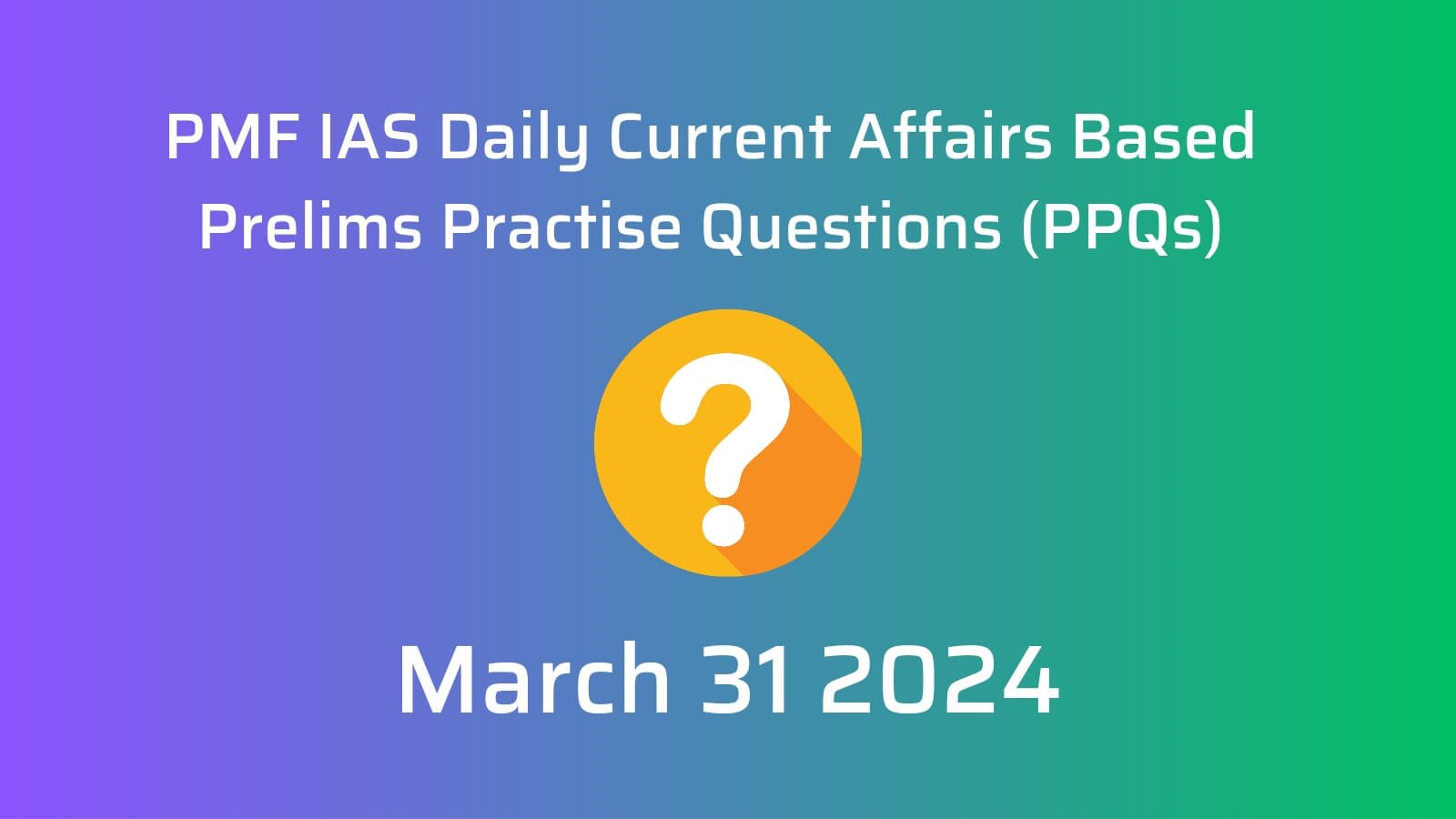
March 31 2024 Prelims Practice Questions (PPQs)
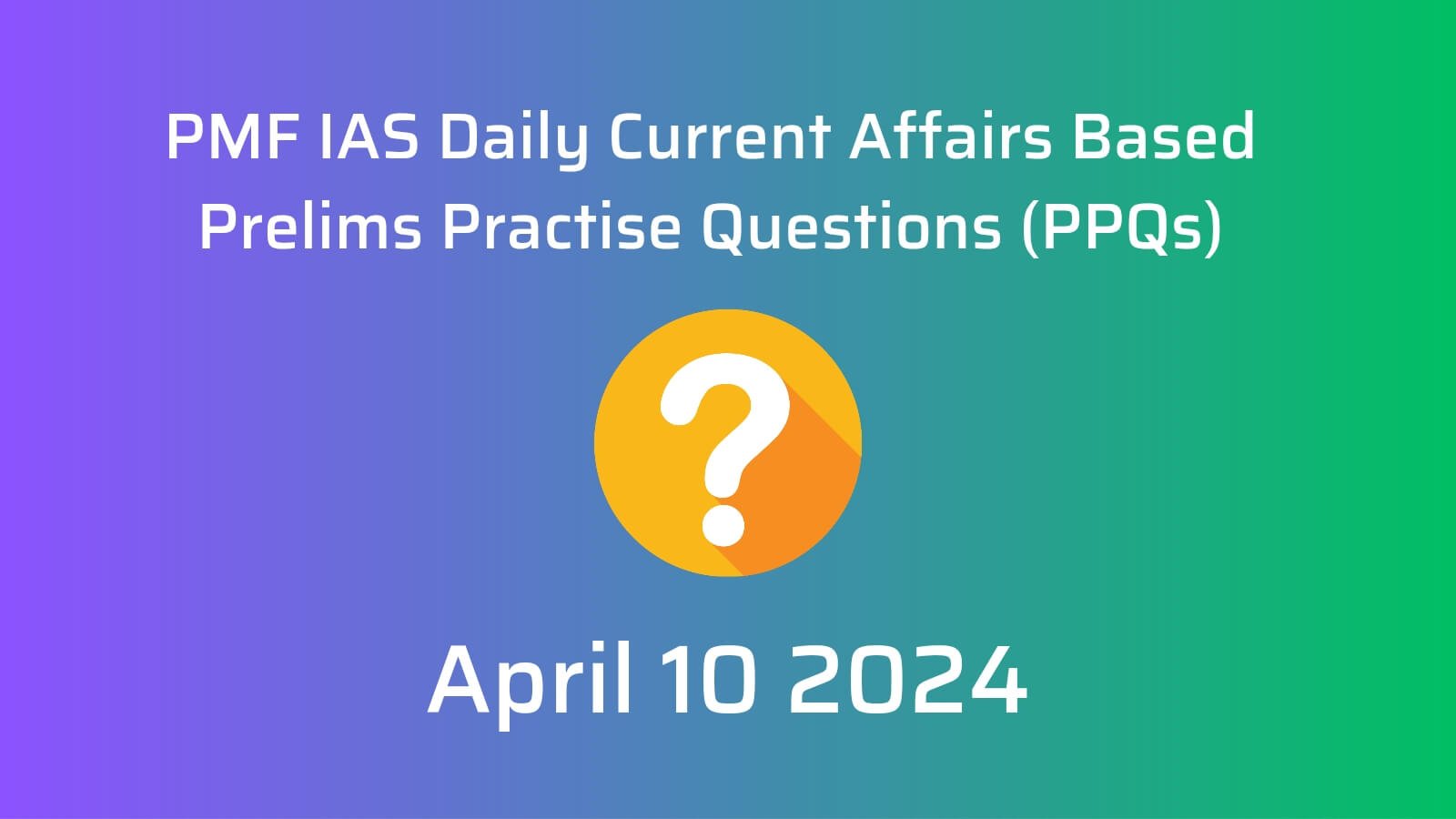
April 10 2024 Prelims Practice Questions (PPQs)
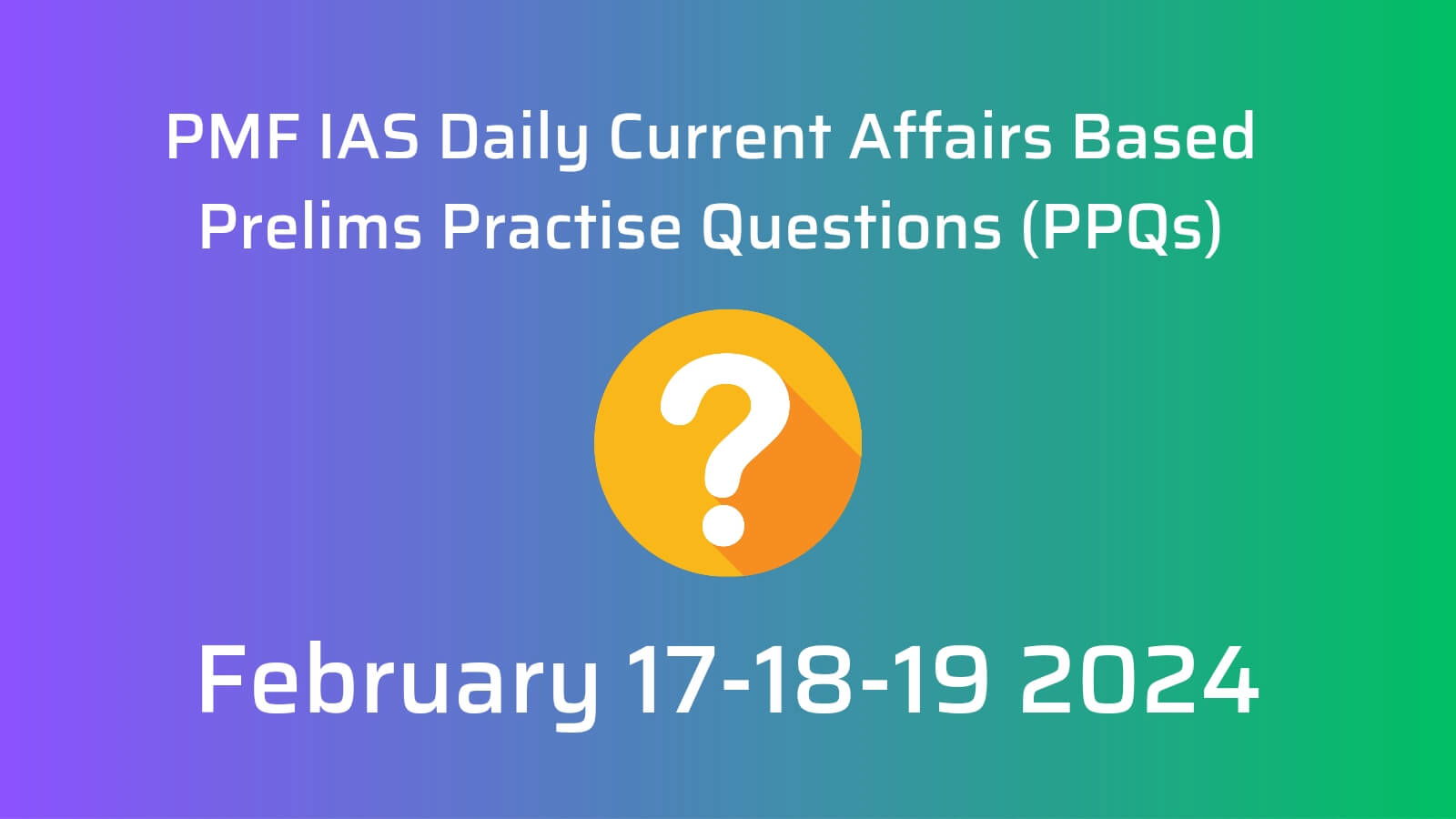
February 17-18-19 2024 Prelims Practice Questions (PPQ)
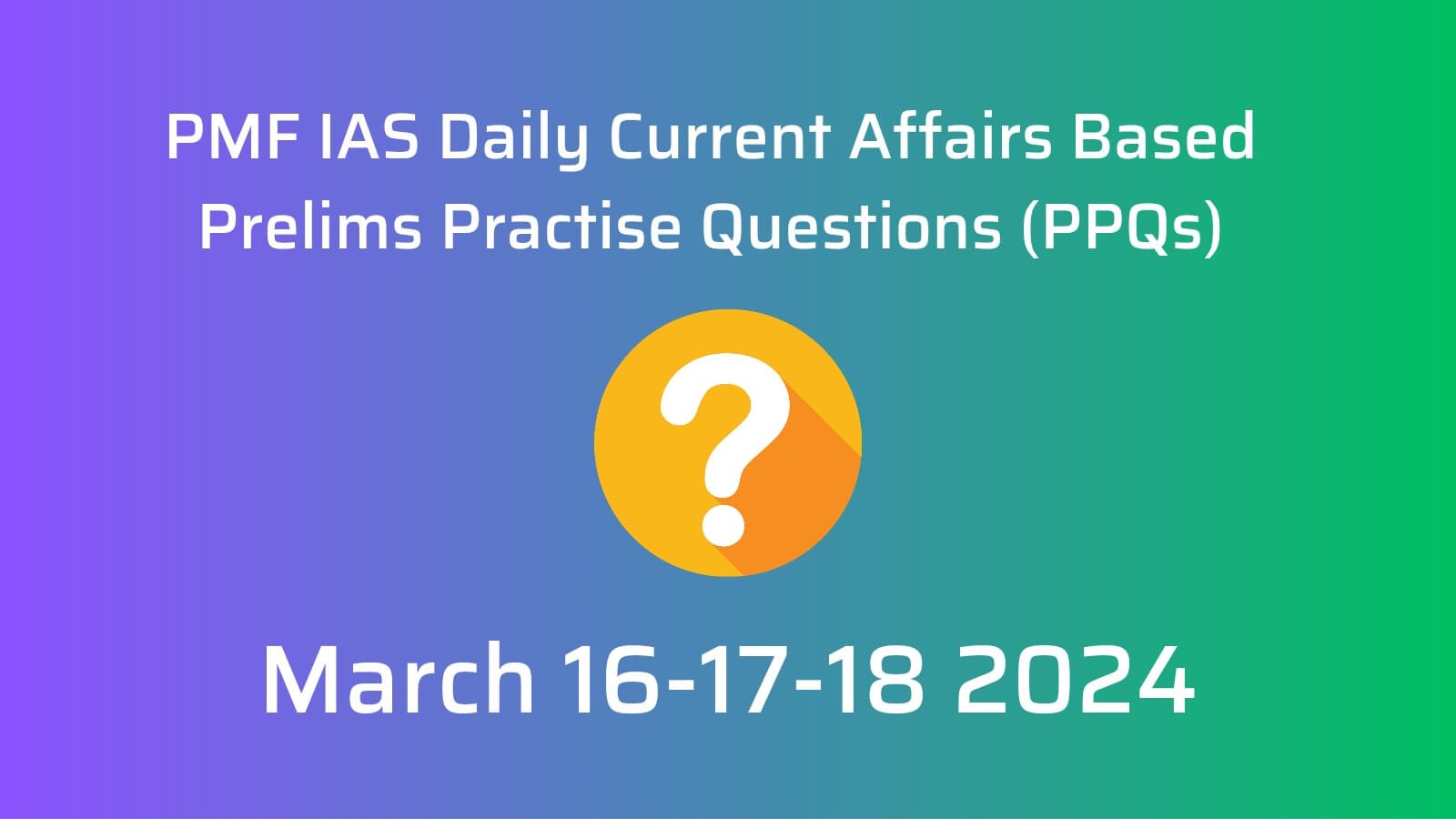
March 16-17-18 2024 Prelims Practice Questions (PPQs)
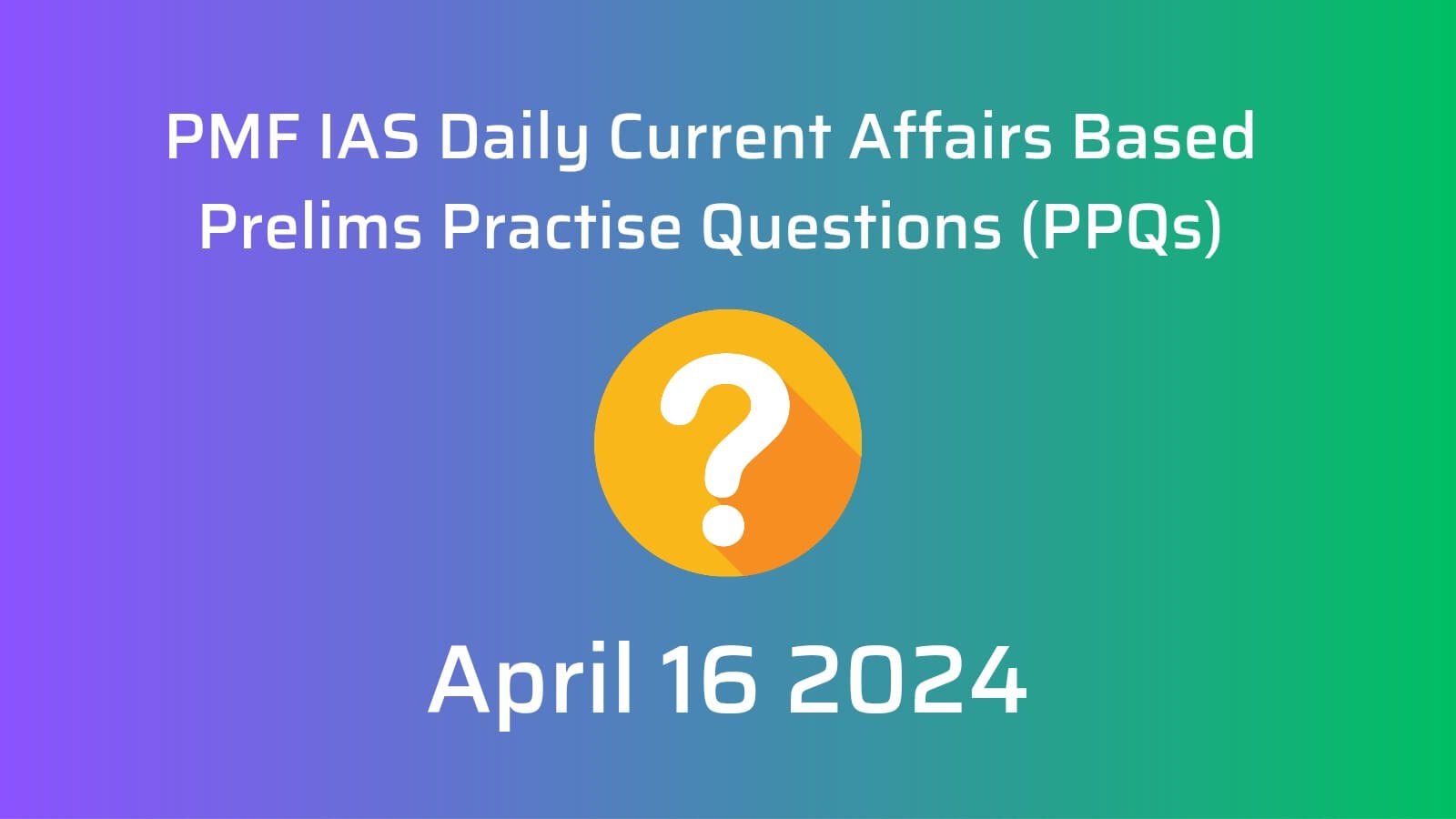
April 16 2024 Prelims Practice Questions (PPQs)
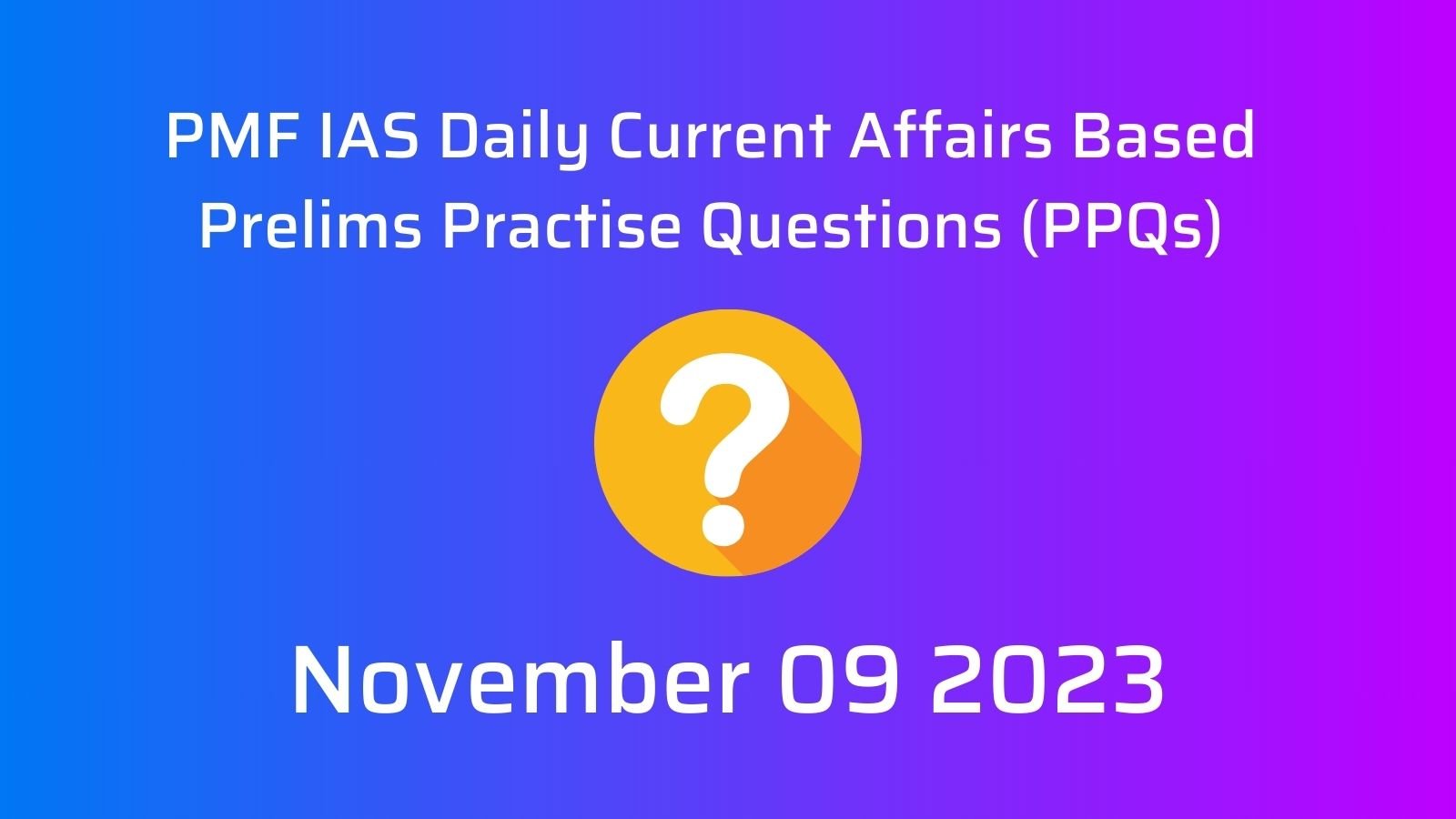
Daily Prelims Practise Questions (PPQs) – November 09 2023
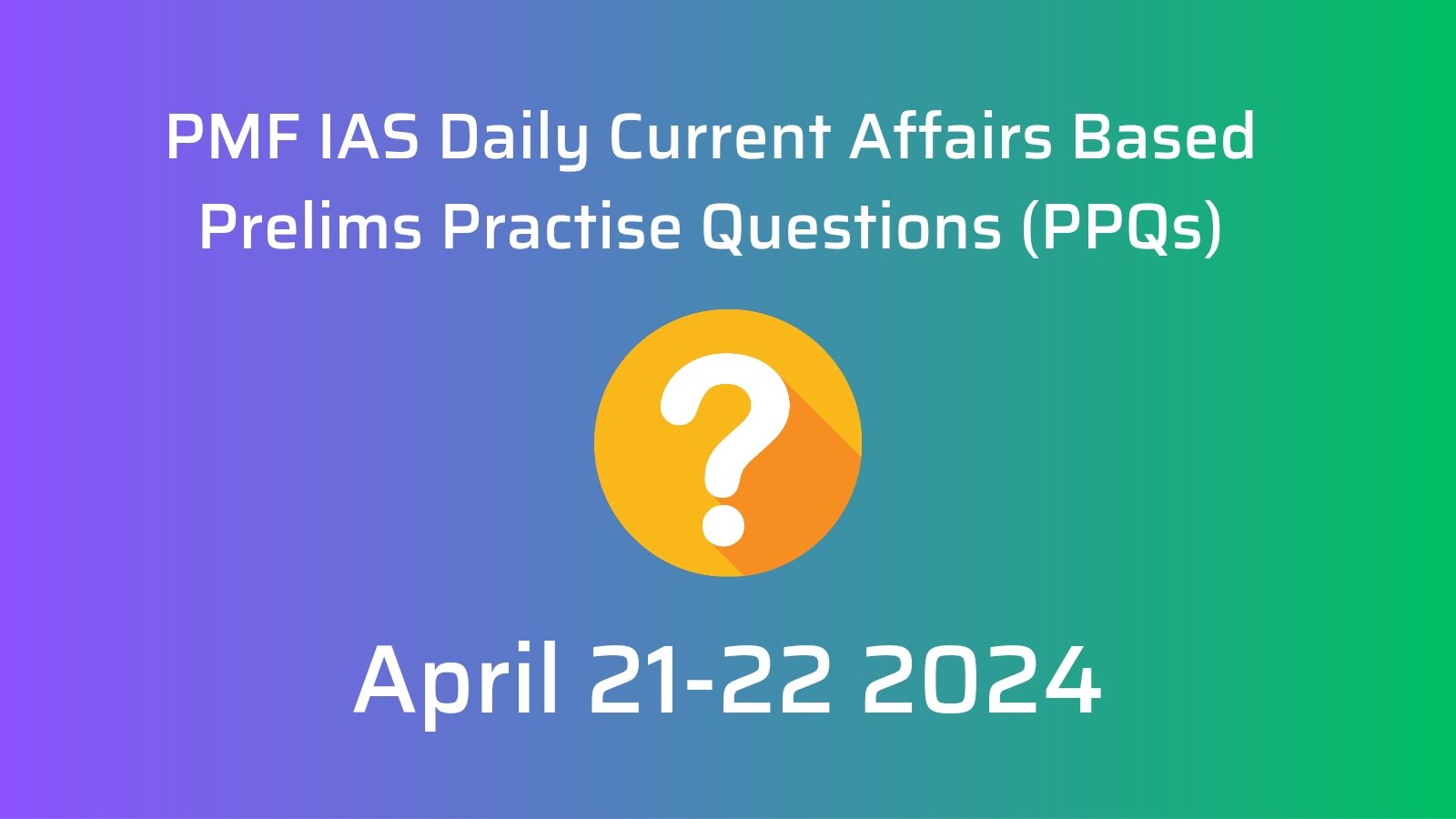
April 21-22 2024 Prelims Practice Questions (PPQs)
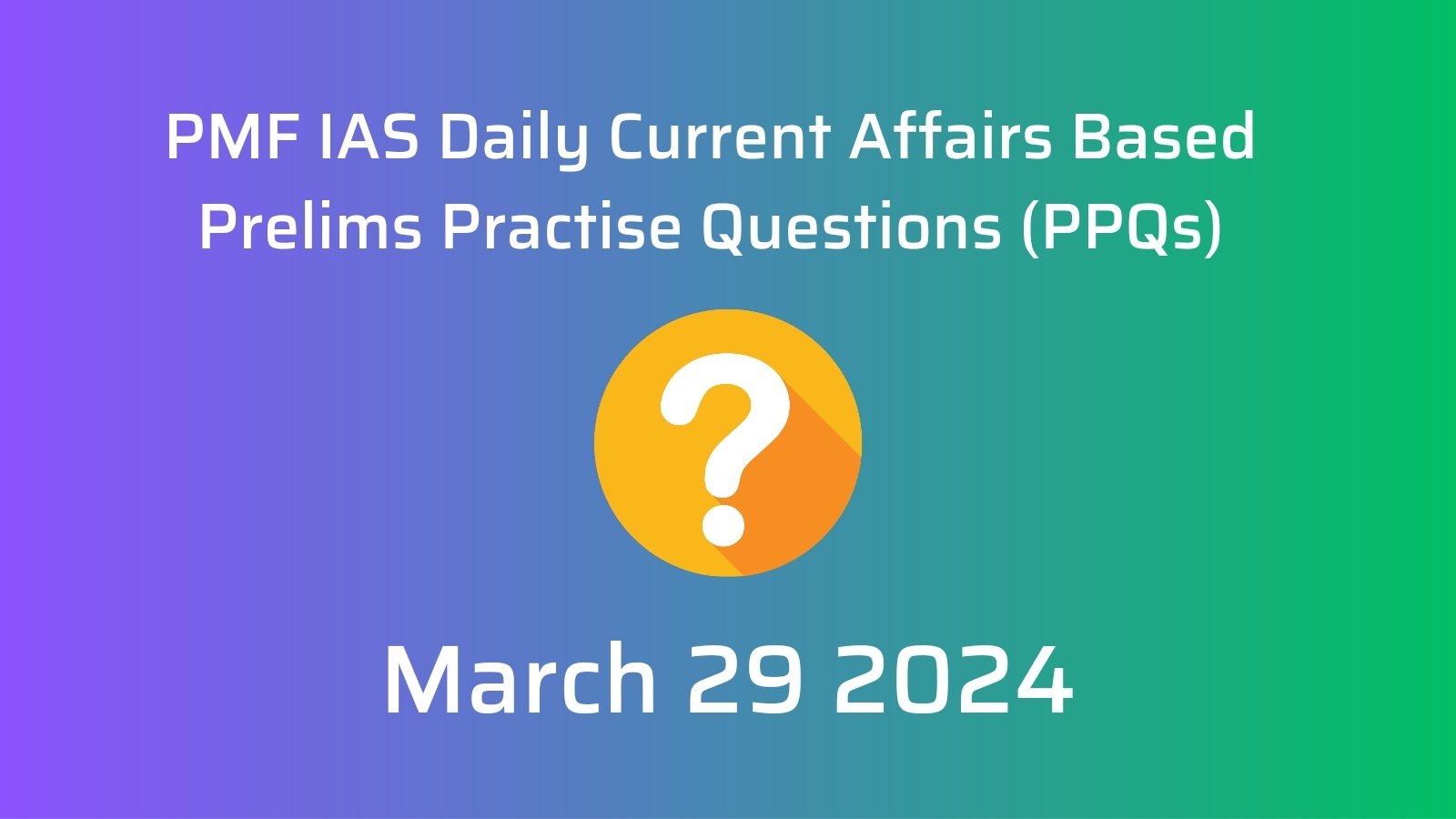




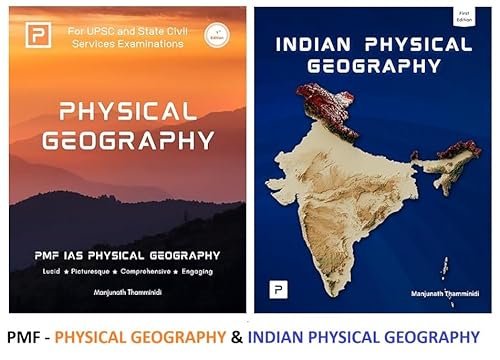
![PMF IAS Environment for UPSC 2022-23 [paperback] PMF IAS [Nov 30, 2021]…](https://pmfias.b-cdn.net/wp-content/uploads/2024/04/pmfiasenvironmentforupsc2022-23paperbackpmfiasnov302021.jpg)


